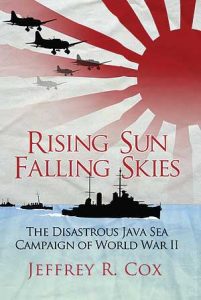Rising Sun, Falling Skies – The Disastrous Java Sea Campaign of World War II. By Jeffrey R. Cox. Osprey Publishing, Oxford, 2014. Hardback of 487 pages with b&w photographs and plans, rrp £20.
This well researched volume by an American lawyer and historian endeavours to consider, even-handedly, the overall Allied effort in this campaign. It starts with Pearl Harbor on 7 December 1941 but does not dwell long there as this was only one part of a Japanese strategic plan to control the ‘Southern Resources Area’. To achieve this it was necessary to drive Americans and Europeans out of East Asia, which could be offered independence under Japanese suzerainty.
The scene is set with Commodore Matthew Perry sailing into Tokyo Bay in 1853, awakening Japan from isolation, sowing the seeds for modernisation, resulting in competition with America and European colonial powers. Japan was not only copying industrially but politically, extending its territories by annexing lands from a disintegrating Chinese empire. This led to a collision with Russia and an alliance with Great Britain, propelling Japan to a position of armed superiority by the early 1930s. With continuous armed conflict throughout China and Korea for the next decade, the Japanese were battle hardened and developed superior weapon systems. They also became strategically astute in managing East Asian affairs.
On paper, American, British and Dutch forces in the Far East should have withstood initial enemy attacks until reinforcements were found, but Pearl Harbor badly damaged and immobilized the US Pacific Fleet. Within hours Japanese aircraft also struck the Philippines, leaving regional American air power in ruins. This brought further misfortunes to the US Asiatic Fleet based there. The British fortress of Singapore was next tested and within days the pride of its fleet lay at the bottom of the South China Sea. The early capitulation of both Singapore and the Philippines, with many thousands taken prisoner, resulted in withdrawal to the East Indies and the establishment of a new coordinated American, British, Dutch & Australian (ABDA) command.

The main focus of the work however remains in the Dutch East Indies. Here the composition of ABDA is examined, with problems of disparate commands hastily brought together to form a multinational defence force. While the Dutch were committed to preventing an overall invasion of what many regarded as their homeland, they lacked the resources to counter aggressive Japanese attacks. Most importantly there was little or no air cover afforded to Allied forces. Compounding problems arose in joint communications and an indigenous population which was not always sympathetic and reliable. In February 1942 the Japanese launched a twin-pronged amphibious invasion force, with Eastern and Western Invasion Fleets, aimed at the capture of Java. The ABDA command placed most of its ships under Rear Admiral Karl Doorman with a fleet intended to halt or at least stall the invader. The ensuing Battle of the Java Sea ended in disaster, with this battle and subsequent engagements seeing the loss of numerous ships including HNLM Ships De Ruyter and Java, HMS Exeter, HMAS Perth and USS Houston. With virtually no major warships and few aircraft ABDA collapsed. A final withdrawal of limited assets was made to Australia before a counter offensive could be organised to fight another day.
This book has wide appeal not only to historians and scholars but to those wishing to explore this fascinating period of naval and military history. As a reference it is well indexed. An extensive bibliography demonstrates the depth of research and copious endnotes are illuminating.
Reviewed by Liz Colthorpe.




